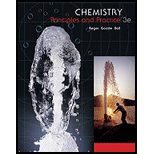
Concept explainers
(a)
Interpretation:
The percent yield of
(a)
Explanation of Solution
The balanced equation for the reaction between
Number of moles of each reactant has to be determined:
Then calculate the equivalent amount of
Use the number of moles of the limiting reactant to calculate the yield:
The percent yield is the actual yield of the reaction divided by the theoretical yield, times
(b)
Interpretation:
A
(b)
Explanation of Solution
The balanced equation for the reaction between
Number of moles of each reactant has to be determined:
The reactant that is present in excess is sodium hydroxide.
Mass of sodium hydroxide remained is
Want to see more full solutions like this?
Chapter 3 Solutions
Chemistry
- 3.105 Nitric acid is often sold and transported as a concentrated 16 M aqueous solution. How many gallons of such a solution would be needed to contain the roughly 2.1109 pounds of HNO3 produced annually in the United States?arrow_forward4.8 In an experiment carried out at very low pressure, 13x1015 molecules of H2 are reacted with acetylene, C2H2, to form ethane, C2H6, on the surface of a catalyst. Write a balanced chemical equation for this reaction. How many molecules of acetylene are consumed?arrow_forwardUrea is used as a fertilizer because it can react with water to release ammonia, which provides nitrogen to plants. (NH2)2CO(s) + H2O() 2 NH3(aq) + CO2(g) (a) When 300. g urea and 100. g water are combined, calculate the mass of ammonia and the mass of carbon dioxide that form. (b) Calculate the mass of the excess reactant that remains after reaction.arrow_forward
- You take 1.00 g of an aspirin tablet (a compound consisting solely of carbon, hydrogen, and oxygen), burn it in air, and collect 2.20 g CO2 and 0.400 g H2O. You know that the molar mass of aspirin is between 170 and 190 g/mol. Reacting 1 mole of salicylic acid with I mole of acetic anhydride (C4H6O3) gives you 1 mole of aspirin and 1 mole of acetic acid (C2H4O2). Use this information to determine the molecular formula of salicylic acid.arrow_forward4.69 The pictures below show a molecular-scale view of a chemical reaction between H2 and CO to produce methanol, CH3OH. The box on the left represents the reactants at the instant of mixing, and the box on the right shows what is left once the reaction has gone to completion. Was there a limiting reactant in this reaction? If so, what was it? Write a balanced chemical equation for this reaction. As usual, your equation should use the smallest possible whole number coefficients for all substances.arrow_forward4-93 Ammonia is prepared industrially by the reaction of nitrogen and hydrogen according to the following equation: If 29.7 kg of N2 is added to 3.31 kg of H2, (a) Which reactant is the limiting reagent? (b) How many grams of the other reactant are left over? (c) How many grams of NH3 are formed if the reaction goes to completion?arrow_forward
 Chemistry: Principles and PracticeChemistryISBN:9780534420123Author:Daniel L. Reger, Scott R. Goode, David W. Ball, Edward MercerPublisher:Cengage Learning
Chemistry: Principles and PracticeChemistryISBN:9780534420123Author:Daniel L. Reger, Scott R. Goode, David W. Ball, Edward MercerPublisher:Cengage Learning Chemistry: The Molecular ScienceChemistryISBN:9781285199047Author:John W. Moore, Conrad L. StanitskiPublisher:Cengage Learning
Chemistry: The Molecular ScienceChemistryISBN:9781285199047Author:John W. Moore, Conrad L. StanitskiPublisher:Cengage Learning Introduction to General, Organic and BiochemistryChemistryISBN:9781285869759Author:Frederick A. Bettelheim, William H. Brown, Mary K. Campbell, Shawn O. Farrell, Omar TorresPublisher:Cengage Learning
Introduction to General, Organic and BiochemistryChemistryISBN:9781285869759Author:Frederick A. Bettelheim, William H. Brown, Mary K. Campbell, Shawn O. Farrell, Omar TorresPublisher:Cengage Learning World of ChemistryChemistryISBN:9780618562763Author:Steven S. ZumdahlPublisher:Houghton Mifflin College Div
World of ChemistryChemistryISBN:9780618562763Author:Steven S. ZumdahlPublisher:Houghton Mifflin College Div Chemistry for Engineering StudentsChemistryISBN:9781337398909Author:Lawrence S. Brown, Tom HolmePublisher:Cengage Learning
Chemistry for Engineering StudentsChemistryISBN:9781337398909Author:Lawrence S. Brown, Tom HolmePublisher:Cengage Learning Chemistry: An Atoms First ApproachChemistryISBN:9781305079243Author:Steven S. Zumdahl, Susan A. ZumdahlPublisher:Cengage Learning
Chemistry: An Atoms First ApproachChemistryISBN:9781305079243Author:Steven S. Zumdahl, Susan A. ZumdahlPublisher:Cengage Learning





